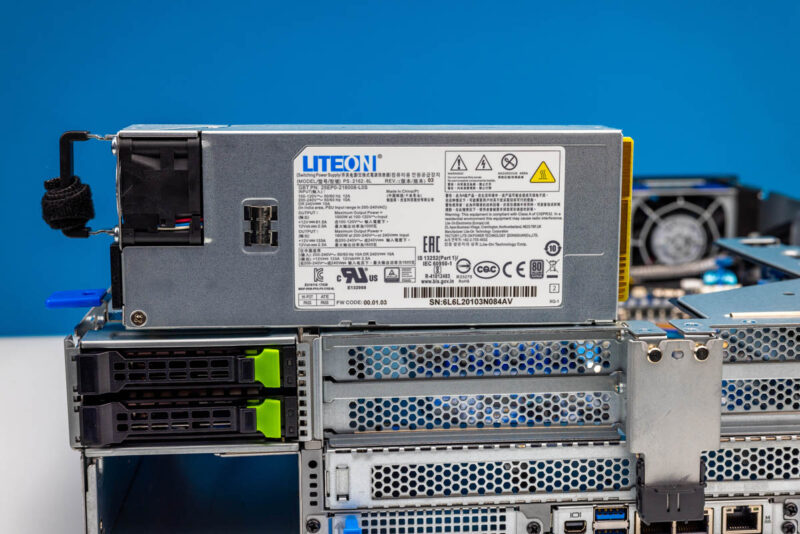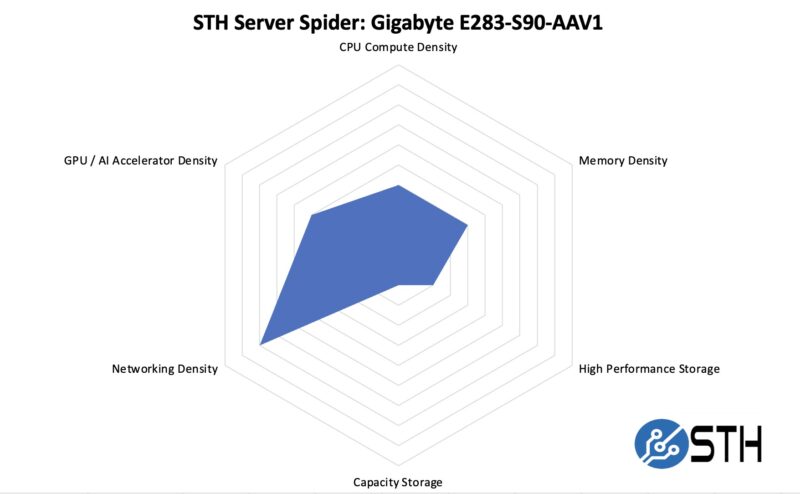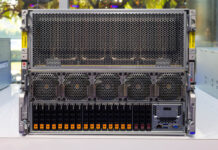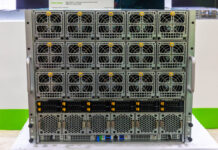Gigabyte E283-S90 Power Consumption
The server comes with redundant LiteOn 1.6kW 80Plus Titanium power supplies.

Using dual 350W TDP CPUs from 4th or 5th Gen Xeon one can get this server to use 900W without filling the expansion slots. Of course, the idle power consumption differences can be quite large on the higher core count parts as we covered in our We Found Something Testing the 5th Gen Intel Xeon Scalable CPUs piece. We somewhat expect that this platform will have several expansion cards installed, and with DPUs that can easily use 75W per slot these days, the 1.6kW power supply seems about right.
STH Server Spider: Gigabyte E283-S90
In the second half of 2018, we introduced the STH Server Spider as a quick reference to where a server system’s aptitude lies. Our goal is to start giving a quick visual depiction of the types of parameters that a server is targeted at.

On one hand, we do not get maximum compute density, nor maximum storage density. On the other hand, we get plenty of room to add networking and AI inference accelerators in the eight total expansion slots.
Final Words
When I first saw the system after the team had taken photos, I totally missed the point of this server. If you are accustomed to seeing lots of front-panel storage, then this server is going to be a bit shocking. On the other hand, Gigabyte executed a few things very well, including being able to cool higher-end processors in a 24.6″ deep chassis, and the riser situation was a step up from the company’s older designs. Small details like the rigid riser guides may get glossed over in online photos, but having used many generations of Gigabyte servers, it was obvious here.

To us, the edge server market often ends up being very specialized. If you have the ability to handle full-depth servers, then we would likely opt for a standard server design instead. On the other hand, if this is the right form factor for your application, then you can fit a lot of CPU, memory, and PCIe expansion cards in a relatively short-depth server using the Gigabyte E283-S90-AAV1.




What’s the reliability like for Gigabyte servers? I’ve had a few of their components over the years (motherboards, video cards and power supplies) and I found them pretty flaky and had to return a few, until eventually I got ones that worked well enough for a year or two then developed problems again. Since then I’ve steered clear of them. Are their servers similar in this respect, or do they design them better than their consumer gear?
This looks like it was designed backwards, in comparison to the server in your reviews of: Supermicro Hyper-E / SYS-220HE-FTNR, Gigabyte E251-U70, Supermicro ARS-210ME-FNR 2U or ASUS EG500-E11 and (not reviewed) Asus EG520-E11-RS6-R.
Were it necessary to have rear I/O Mitxpc seems to have a good idea with their mini rackmount servers with rear-io; where the I/O is reversible, and can be moved to the front instead.
If you plan on swapping out fans more than anything else I can see the benefit of this design.
Still, thanks for reviewing this, as it caters to someone who wants this; maybe for their colocated rack power sized systems.
Is there a way to search the server reviews based on the spider score? Say I am interested in high compute density and would like to just read the reviews above a particular score?
Hey Ryan – We do not have this, but it is a good idea. We probably need to time or generational bound it as well. A high density CPU compute from 2019 with 64 cores/ socket will be very tiny by Q1 2025.
I cannot see any U2 or U3 SSD slots… instead poor old SATA !
Last year, I have been able to buy KINGSTON U2 Enterprise for less than their SATA counterpart. But these excellent U2 have been discontinued and not replaced by Kingston.
Nevertheless, the Micron U3 are accepted by my DELL PowerEdge R650.
I still see a lot of crazy high prices for 12 Gb SAS SSDs which are faster than SATA but really slower if you compare to NVMe PCIe gen3 or gen4.
Maybe the reason of this situation comes from CTOs afraid of buying their SSDs from a third party seller and stuck with the server manufacturer (ie DELL, HP, Lenovo).